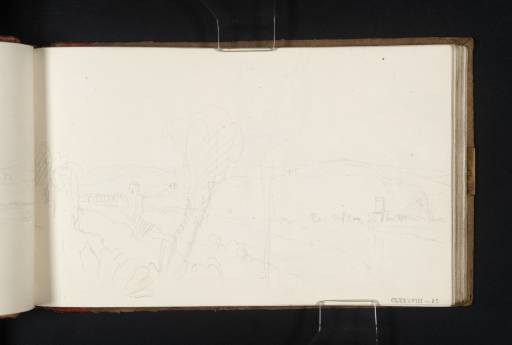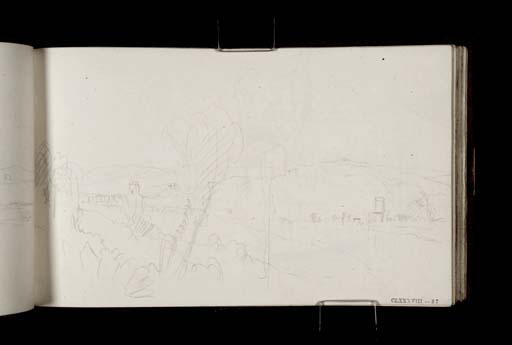Joseph Mallord William Turner Landscape near Rome with the Ponte Molle and the Torre Lazzaroni 1819
Image 1 of 2
Joseph Mallord William Turner,
Landscape near Rome with the Ponte Molle and the Torre Lazzaroni
1819
Joseph Mallord William Turner 1775–1851
Folio 38 Recto:
Landscape near Rome with the Ponte Molle and the Torre Lazzaroni 1819
D16220
Turner Bequest CLXXXVIII 37
Turner Bequest CLXXXVIII 37
Pencil on white wove paper, 114 x 189 mm
Inscribed by John Ruskin in red ink ‘37’ bottom right (very faint)
Stamped in black ‘CLXXXVIII 37’ bottom right
Stamped in black ‘CLXXXVIII 37’ bottom right
Accepted by the nation as part of the Turner Bequest 1856
References
1909
A.J. Finberg, A Complete Inventory of the Drawings of the Turner Bequest, London 1909, vol.I, p.559, as ‘View, with Ponte Molle (?) in distance’.
This sketch depicts the countryside on the northern outskirts of Rome. Turner’s viewpoint is from the east with the plain of the River Tiber stretching out before him and the heights of Monte Mario beyond. The bridge visible in the mid-distance on the left is the Ponte Molle, see folio 36 (D16217; Turner Bequest CLXXXVIII 35). The circular tower on the banks of the river at the right is the same structure identified in a drawing attributed to Theodoor Wilkens (c.1675–1748), View of the Tiber close to the Fountain of the Acqua Acetosa (Thomas Ashby Collection, Vatican Library) as the Torre Lazzaroni, a tower erected over the remains of a Roman tomb.1 The same landmark was also recorded in c.1822 by American archeologist, John Izard Middleton (1785–1849) as Tomb on the Tiber.2 This area of the Roman campanga was characterised by a number of such towers built for the protection of the city by Leo IV (Pope, 847–855 AD).3 Further sketches of the Torre Lazzaroni can be found in the Naples. Rome C. Studies sketchbook (see Tate D16136–D16139; Turner Bequest CLXXXVII 48–51) and the Small Roman C. Studies sketchbook (Tate D16442; Turner Bequest CXC 32).
The juxtaposition of the ruin with the adjacent bridge along the winding path of the River Tiber would have presented a naturally picturesque subject for artists. Indeed this part of the Roman Campagna was informally known as the ‘Promenade de Poussin’, reflecting its association with the seventeenth-century French master, Nicolas Poussin (1594–1665) who famously sketched here during solitary, meditative walks out of the city from the Porta del Popolo.4 In particular, Turner may have been reminded of the paintings of Claude Lorrain (c.1604–1682). A cylindrical building similar to the tower within this sketch appears in Claude’s The Mill on the Tiber, 1650 (Nelson-Atkins Museum of Art, Kansas City) and The Mill, or the Marriage of Isaac and Rebecca, 1648 (National Gallery, London). The latter was one of two paintings by the French master which Turner requested should be hung in perpetuity next to his own Sun rising through Vapour and Dido building Carthage.5
The view continues on the opposite sheet of the double-page spread, see folio 37 verso (D16219; Turner Bequest CLXXXVIII 36a).
Nicola Moorby
September 2008
See Raymond Keaveney, Views of Rome from the Thomas Ashby Collection in the Vatican Library, exhibition catalogue, Smithsonian Institution, Washington 1988, pp.230–2.
Charles R. Mack and Lyn Robertson (eds.), The Roman Remains: John Izard Middleton’s Visual Souvenirs of 1820–23, South Carolina 1997, pp.162–3.
See Richard Verdi, ‘Poussin’s Life in Nineteenth-Century Pictures’, Burlington Magazine, vol.111, no.801, December 1969, p.742; and Peter Galassi, Corot in Italy: Open-Air Painting and the Classical-Landscape Tradition, New Haven and London 1991, pp.162–3.
How to cite
Nicola Moorby, ‘Landscape near Rome with the Ponte Molle and the Torre Lazzaroni 1819 by Joseph Mallord William Turner’, catalogue entry, September 2008, in David Blayney Brown (ed.), J.M.W. Turner: Sketchbooks, Drawings and Watercolours, Tate Research Publication, December 2012, https://www


